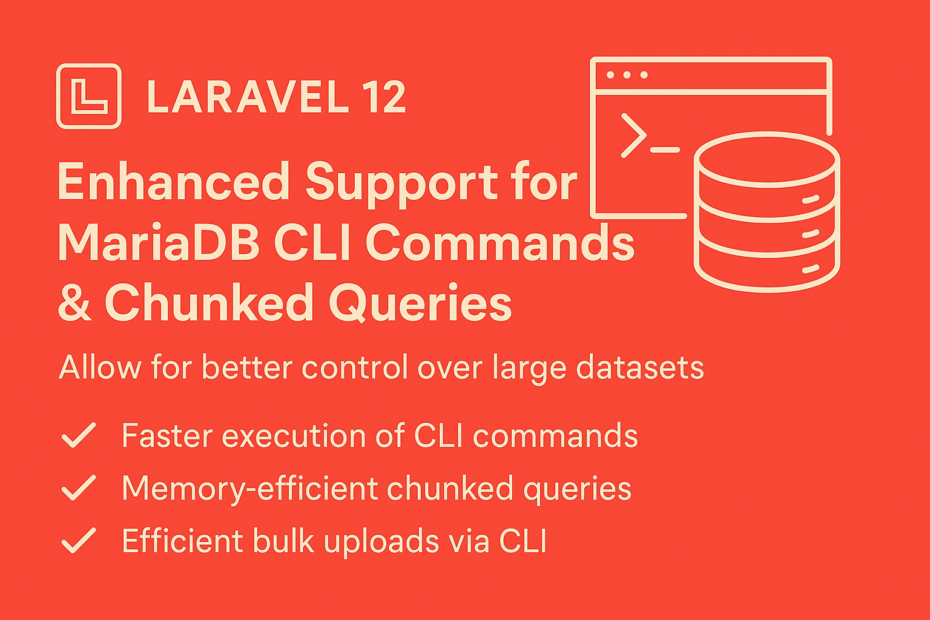Handling large datasets efficiently has always been a challenge in web applications, but Laravel 12 introduces improved support for MariaDB CLI commands and chunked queries, making database operations smoother and more performant.
Why This Matters
MariaDB is a popular open-source database known for its performance and scalability. With Laravel 12, developers can now leverage enhanced CLI command support, making database interactions more seamless. Additionally, the improved chunked queries feature helps optimize performance when working with massive datasets.
🛠 Enhanced MariaDB CLI Commands in Laravel 12
Laravel 12 now integrates deeper with MariaDB, allowing developers to:
✅ Execute Database Operations Directly – More efficient CLI commands for migrations, table modifications, and indexing.
✅ Streamlined Backup & Restoration – Enhanced command-line tools to back up databases faster.
✅ Optimized Indexing & Query Execution Plans – Laravel can now leverage MariaDB’s latest indexing optimizations to speed up queries.
Example: Running a Database Migration
Using Laravel’s migration CLI commands, you can efficiently modify database structures:
php artisan migrate:refresh --database=mariadbOr, execute direct queries using MariaDB’s optimized command structure:
SELECT * FROM users WHERE created_at > '2023-01-01' ORDER BY id DESC;🔄 Improved Chunked Queries for Large Datasets
Chunked queries allow developers to process large amounts of data without overwhelming memory. Laravel 12 optimizes these queries further, ensuring efficient pagination and data fetching.
Why Use Chunked Queries?
✅ Reduces memory consumption by processing small data batches.
✅ Prevents timeouts when dealing with massive datasets.
✅ Enhances scalability by making queries more efficient.
Example: Processing Data in Chunks
Instead of loading all users at once, Laravel allows fetching them in manageable chunks:
User::where('status', 'active')->chunk(100, function ($users) {
foreach ($users as $user) {
// Process each user
echo $user->name;
}
});🚀 Uploading Large Chunks of Data via CLI
When dealing with large datasets, using CLI commands makes inserting data faster and more efficient.
🔹 1. Bulk Insert from a CSV File
MariaDB’s LOAD DATA INFILE command efficiently imports structured data:
LOAD DATA INFILE '/path/to/yourfile.csv'
INTO TABLE users
FIELDS TERMINATED BY ','
LINES TERMINATED BY '\n'
IGNORE 1 ROWS
(name, email, created_at);✅ Best for structured data imports.
🔹 2. Using mysqlimport CLI
MariaDB provides mysqlimport for direct file uploads:
mysqlimport --local --host=127.0.0.1 --user=root --password=db_password \
--fields-terminated-by=',' --lines-terminated-by='\n' \
database_name /path/to/yourfile.csv✅ Quickly import CSV files via CLI.
🔹 3. Batch Inserts for Large Data
Instead of individual inserts, use bulk inserts to reduce query execution time:
INSERT INTO users (name, email, created_at)
VALUES
('John Doe', 'john@example.com', NOW()),
('Jane Doe', 'jane@example.com', NOW()),
('Mike Smith', 'mike@example.com', NOW());🚀 Faster execution, optimized inserts!
🔹 4. Restoring Large Dump Files
If you have a backup .sql file, restore it using:
mysql -u root -p database_name < backup.sqlFor compressed backups, use:
gunzip < backup.sql.gz | mysql -u root -p database_name✅ Best for entire dataset migration & restoration.
🎯 Key Takeaways
- MariaDB CLI integration speeds up database tasks.
- Chunked queries optimize performance when working with large datasets.
- Efficient bulk uploads via CSV, batch inserts, and CLI improve database handling.
With Laravel 12’s enhanced MariaDB support, developers can streamline workflows, reduce memory issues, and scale applications efficiently.
Fuel my creative spark with a virtual coffee! Your support keeps the ideas percolating—grab me a cup at Buy Me a Coffee and let’s keep the magic brewing!
